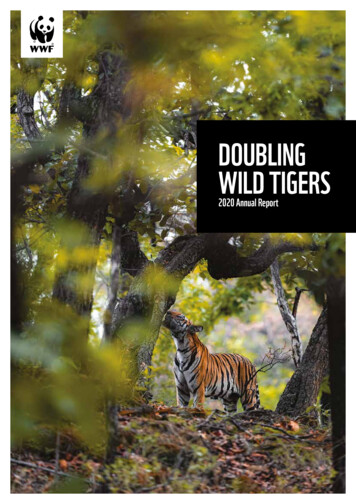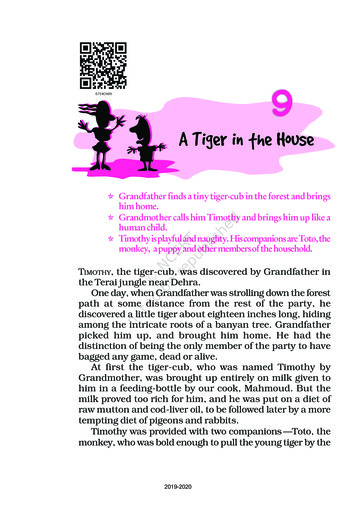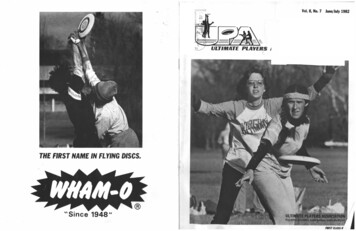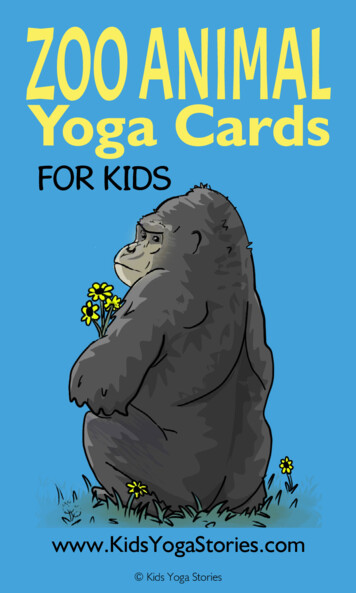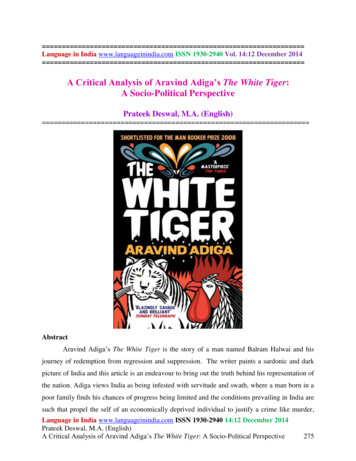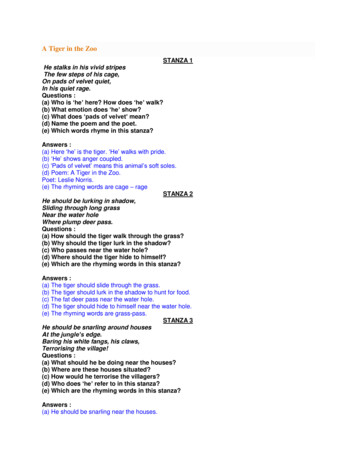
Transcription
A Tiger in the ZooSTANZA 1He stalks in his vivid stripesThe few steps of his cage,On pads of velvet quiet,In his quiet rage.Questions :(a) Who is ‘he’ here? How does ‘he’ walk?(b) What emotion does ‘he’ show?(c) What does ‘pads of velvet’ mean?(d) Name the poem and the poet.(e) Which words rhyme in this stanza?Answers :(a) Here ‘he’ is the tiger. ‘He’ walks with pride.(b) ‘He’ shows anger coupled.(c) ‘Pads of velvet’ means this animal’s soft soles.(d) Poem: A Tiger in the Zoo.Poet: Leslie Norris.(e) The rhyming words are cage – rageSTANZA 2He should be lurking in shadow,Sliding through long grassNear the water holeWhere plump deer pass.Questions :(a) How should the tiger walk through the grass?(b) Why should the tiger lurk in the shadow?(c) Who passes near the water hole?(d) Where should the tiger hide to himself?(e) Which are the rhyming words in this stanza?Answers :(a) The tiger should slide through the grass.(b) The tiger should lurk in the shadow to hunt for food.(c) The fat deer pass near the water hole.(d) The tiger should hide to himself near the water hole.(e) The rhyming words are grass-pass.STANZA 3He should be snarling around housesAt the jungle’s edge.Baring his white fangs, his claws,Terrorising the village!Questions :(a) What should he be doing near the houses?(b) Where are these houses situated?(c) How would he terrorise the villagers?(d) Who does ‘he’ refer to in this stanza?(e) Which are the rhyming words in this stanza?Answers :(a) He should be snarling near the houses.
(b) These houses are at the edge of the jungle.(c) He would terrorise the villagers by showing his fangs and claws.(d) ‘He’ refers to the tiger.(e) The rhyming words are edge-village.STANZA 4But he locked in a concrete cell,His strength behind bars,Stalking the length of his cage,Ignoring visitors.Questions :(a) in what kind of a cell is he locked?(b) Whose strength is behind bars?(c) How does he react to the visitors?(d) Who is being ignored?(e) Name the poem and the poet.Answers :(a) He is locked in a concrete cell.(b) The strength of the locked animal is behind bars.(c) He ignores the visitors.(d) The visitors are being ignored.(e) Poem: A Tiger in the Zoo.Poet: Leslie Norris.STANZA 5He hears the last voice at night,[H.B.S.E. March. 2017 (Set-B)]The patrolling cars,And stares with his brilliant eyesAt the brilliant stars.Questions :(a) What sound does the tiger hear at night?(b) How do his eyes look?(c) At what does he look at night?(d) Which word in the stanza means ‘looks intently’?(e) Which are the rhyming words in this stanza?Ans.(a) The tiger hears the sound of the patrolling cars at night.(b) His eyes look brilliant.(c) He looks at the shining stars at night.(d) The word is ‘stares’.(e) The rhyming words are cars-stars.MULTIPLE CHOICE QUESTIONS1. What does a tiger have on his body?(A) spots(C) starsAns. (B) stripes2. How does a tiger feel in a cage?(A) happy(C) freeAns. (D) angry(B) stripes(D) all of the above(B) contented(D) angry
3. How are the pads of a tiger?(A) velvet(B) rough(C) hard(D) all of the aboveAns. (A) velvet4. What does the tiger hunt near the water hole?(A) lions(B) elephants(C) deer(D) all of the aboveAns. (C) deer5. Where do the tigers hunt the deer?(A) in the cage(B) near the water hole(C) near the cage(D) all of the above.Ans. (B) near the water hole6. Where should the tiger be snarling?(A) at the jungle’s edge(B) at the cage’s edge(C) in the cage(D) all of the aboveAns. (A) at the jungle’s edge7. A tiger Is happy when .(A) he is in the cage(B) he is near the cage(C) he frightens the visitors(D) he is free in the forestAns. (I)) he is a tree in the forest8. What is the tiger’s attitude towards visitors?(A) loving(B) hating(C) ignoring(D) threateningAns. (C) ignoring9. What is patrolling at night?(A) can(B) tigers(C) deer(D) all of the aboveAns. (A) cars10. How are the eves of the tiger?(A) dull(B) brilliant(C) sleepy(D) sadAns. (B) brilliant11. What is ‘brilliant’ in the poem ‘Tiger in the Zoo’?(A) the tiger’s eyes(B) the stars(C) both (A) and (B)(D) none of the aboveAns. (C) both (A) and (B)Extract Based / comprehension test Questions and AnswersRead the extracts and answer the questions that follow.He stalks in his vivid stripesThe few steps of his cage,On pads of velvet quiet,In his quiet rage.(a) Who is ‘He’ in the above lines?(b) Where is he?(c) Where and how is he walking?(d) In which mood is he? Why?Ans. (a) Tiger.(b) In a small cage.(c) He walks in his cage slowly and quietly with firm strides in a proud manner.(d) He is angry because instead of moving freely in the forest, he is confined to a small cage.2. He should be lurking in shadow,
Sliding through long grassNear the waterholeWhere plump deer pass.(a) Where is the tiger hiding?(b) Who is going to be his prey?(c) Why should he be lurking in shadow?(d) What is the rhyme scheme of these lines?Ans. (a) He is hiding in a shadowy dark place in the long grass.(b) A fat deer who will come that way to drink water is going to be his prey.(c) He should be lurking in shadow to attack the deer who comes to drink water at the waterhole.(d) a b c b.3. He should be snarling around housesAt the jungle’s edge,Baring his white fangs, his claws,Terrorising the village!(a) The poet says ‘He should be .’, which means that he is not doing it at present so where is heand what is he doing?(b) Where should ‘he’ be?(c) What is ‘his’ attitude towards visitors?(d) How does he terrorise the villagers?Ans. (a) He is in a village showing his white teeth and claws. He is terrorising villagers.(b) In the forest.(c) He is terrorising the villagers.(d) He terrorises the villagers by showing his sharp teeth and claws and growling.4. But he’s locked in a concrete cell,His strength behind bars,Stalking the length of his cage,Ignoring visitors,(a) What does the expression —stalking the length of his cage’ imply?(b) Was he interested in the visitors(c) Which expression tells you this?(d) What kind of enclosure the tiger was kept in?Ans. (a) It means the tiger was walking from one end of the cage to another as if trying to measurethe length of the cage.(b) No, he was not.(c) The expression—’ignoring visitors’ tells us this.(d) He was kept in a cell made of concrete walls and long, strong bars so that the tiger could notescape.5. He hears the last voice at night,The patrolling cars,And stares with his brilliant eyesAt the brilliant stars.(a) What does he hear at night in the zoo?(b) What do you think he might be hearing when he was in the forest?(c) How do the eyes of a tiger look at night?(d) Why do they look so?
Ans. (a) He hears the sounds of cars of guard making rounds to check if everything was right.(b) He must be hearing the sound of other wild animals.(c) They look bright and shining.(d) This is because of a characteristic of the cat family to which they belong.Extra Very Short Answer Type Important Questions1.Read the poem again, and work in pairs or groups to do the following tasks.(i) Find the words that describe the movements and actions of the tiger in the case and inthe wild. Arrange them in two columns.(ii) Find the words that describe the two places, and arrange them in two columns.Now try to share ideas about how the poet uses words and images to contrast the twosituations.Ans: (i)In the cageIn the wildStalksLurking in shadowFew steps of his cageSliding through long grassQuiet rageSnarling around housesLocked in a concrete cellBaring his white fangs, his clawsStalking the length of his cageTerrorising the villageIgnoring visitorsStares at the brilliant stars(ii)CageWildFew steps of his cageShadowConcrete cellLong grassLockedWater holeBehind barsPlump deerVisitorsHouses at the jungle’s edgePatrolling carsVillage
2.Notice the use of a word repeated in lines such as these:(i) On pads of velvet quiet,In his quiet rage.(ii) And stares with his brilliant eyesAt the brilliant stars.What do you think is the effect of this repetition?Ans: This repetition is a poetic device used by the poet in order to increases the intensity of thetiger’s rage and his helpless silence. ‘Velvet quiet’ refers to the quiet velvetpads of the tiger,which cannot run or leap. They can only walk around the limited space in the cage. The use of‘quiet rage’ symbolises the anger and ferocity that is building up inside the tiger as it wants torun out into the forest and attack a deer, but the rage is quiet because it cannot come out in theopen as it is in the cage.This double use of ‘quiet’ has brought immense beauty to the poem. Similarly, the use of‘brilliant’ for the tiger’s eyes as well as the stars also brings out the magnificence of these lines.The tiger has dreams of being free in its ‘brilliant’ eyes. It sees the stars (that have also beendescribed as brilliant) with the same eyes. It stares at the brilliant stars with its brilliant eyesthinking about how beautiful its life could be in the forest. The repetitiveness of these wordsgives a wonderful effect to the poem.3.Read the following two poems one about a tiger and the other about a panther. Thendiscuss:Are zoos necessary for the protection or conservation of some species of animals? Are theyuseful for educating the public? Are there alternatives to zoos?The TigerThe tiger behind the bars of his cage growls,The tiger behind the bars of his cage snarls,The tiger behind the bars of his cage roars.Then he thinks.It would be nice not to be behind bars allThe timeBecause they spoil my viewI wish I were wild, not on show.But if I were wild, hunters might shoot me,But if I were wild, food might poison me,But if I were wild, water might drown me.Then he stops thinkingAnd The tiger behind the bars of his cage growls,The tiger behind the bars of his cage snarls,The tiger behind the bars of his cage roars.PETER NIBLETTThe PantherHis vision, from the constantly passing bars,has grown so weary that it cannot holdanything else. It seems to him there are
a thousand bars; and behind the bars, no world.As he paces in cramped circles, over and over,the movement of his powerful soft stridesis like a ritual dance around a centrein which a mighty will stands paralysed.Only at times, the curtain of the pupilslifts, quietly. An image enters in,rushes down through the tensed, arrested muscles,plunges into the heart and is gone.RAINER MARIA RILKEAns: The Zoo is very necessary place for some animals asthey could be hunted down, poisonedby some wild food, or could drown in water in the forest. They also aware public about thenature of animals and make human friendly with animals. However, a zoo is not the correctsubstitute for a forest. In a zoo, an animal would feel caged, bound, and not free to roam about inthe wild. It is for this reason that wildlife sanctuaries and national parks have been instituted inorder to conserve several endangered species. These places provide protection as well as naturalsurroundings to these species.They can roam about freely in their habitats and are safe too. The public can visit these parks andget educated about the animals and their lifestyles. The parks and sanctuaries are run using astrict set of rules, the most prominent being the ban on hunting. Since the animals are in theopen, visitors would not be able feed them and would not misbehave or try to play with them asthey are under strict guidance. Such incidents have been recorded in zoos where people irritateand tease the animals. Hence, a wild life sanctuary is a good alternative for animals to be safe aswell as in their natural surroundings.
tiger’s rage and his helpless silence. ‘Velvet quiet’ refers to the quiet velvetpads of the tiger, which cannot run or leap. They can only walk around the limited space in the cage. The use of ‘quiet rage’ symbolises the anger and fer
